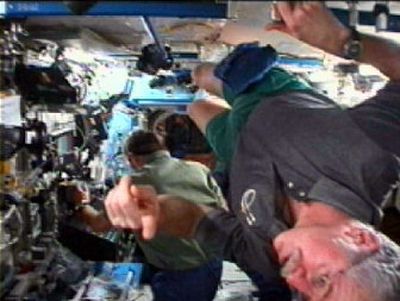NASA tackles foam loss

SPACE CENTER, Houston – NASA’s boss took responsibility Friday for the alarming loss of a big piece of fuel-tank insulation from Discovery and refused to give up on flying another space shuttle later this year.
Administrator Michael Griffin said a new “tiger team” of engineers will seek solutions to the problem that brought down Columbia and continues to haunt the space agency. “By being smart and working hard,” NASA might be able to launch another shuttle by year’s end, he said.
“I think we’re going to fix it in short order and we’re going to get back flying,” Griffin told journalists in a telephone linkup from Washington. “We don’t expect this to be a long, drawn-out affair, to be honest with you.”
Nonetheless, Griffin has his staff looking at what Discovery’s astronauts can do to help out the international space station over the next week – like leaving any surplus food, water, laptop computers or other supplies, just in case the shuttle fleet is grounded for longer. Mission managers, in fact, may keep Discovery docked at the station an extra day because of the extra work, which would stretch the shuttle flight to 13 days.
Asked if he takes responsibility for the space agency’s failure to make sure big pieces of foam debris didn’t fly off the shuttle at launch, Griffin replied, “Absolutely.”
Discovery lost four pieces of foam during Tuesday’s liftoff that were “bigger than we wanted to see come off,” he said.
Despite 21/2 years of tank redesign and hundreds of millions of dollars spent on that alone, Griffin acknowledged “we clearly haven’t done our best yet.”
But he pointed out that Discovery does have six times fewer dings and scrapes than the average flight before Columbia’s catastrophic return.
As for the seven Discovery astronauts, Griffin called them “a brave crew.” Commander Eileen Collins, he noted, is a former test pilot, and now the other crew members are also in the “test pilot business, even if they didn’t start out that way.”
Griffin said NASA erred by not modifying the area of the external fuel tank where the nearly 1-pound chunk of foam flew off. Engineers considered repairing that section after the 2003 Columbia accident, but put it off based on their ability to test the foam there and past flights that didn’t indicate problems.
“We came to the wrong conclusion, I mean, very obviously, because we don’t want pieces of foam like that coming off,” he said.
Even though Griffin did not assume NASA’s top job until April, long after decisions about testing the foam had been made, he checked into it and endorsed it.
The chairman of NASA’s return-to-flight oversight group said Friday that his panel also supported the space agency’s rationale for not fixing the troublesome foam area – in retrospect a mistake.
“Clearly, clearly, the rationale that we accepted was wrong and the flight test demonstrated that,” said chairman Richard Covey, a former shuttle commander.
Covey noted that the space agency’s assumption that it could use noninvasive techniques to check the foam for air pockets, which could weaken the insulation and cause it to pop off, “has all been challenged by what happened on the launch.”
In orbit, Collins expressed disappointment at the unfortunate turn of events.
“I don’t think we should fly again unless we do something to prevent this from happening again,” she said in one of several radio interviews early Friday. “We thought we had that problem licked.”